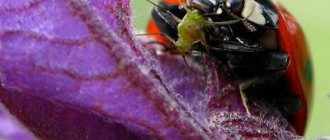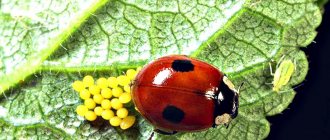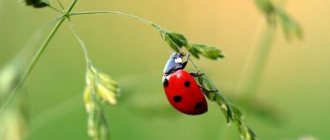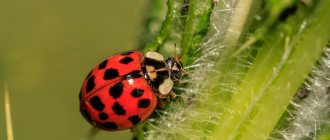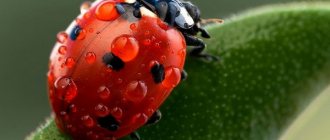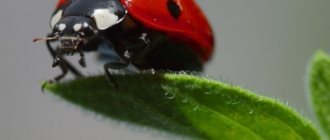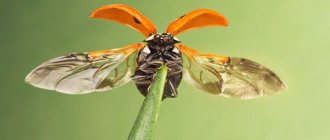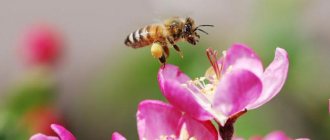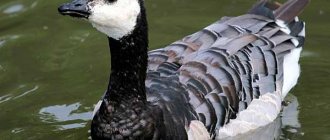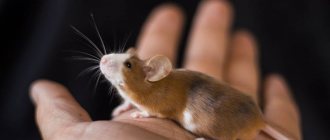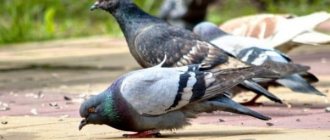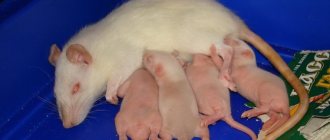Ladybugs can sometimes fly to your apartment or house in early to mid-autumn. Most people have a favorable attitude towards these cute insects, despite the fact that by nature they are pronounced predators.
Ladybug eats apple jam
Read on dacha6.ru:
How to help a baby crow that has fallen out of its nest
How to deal with autumn and winter blues
In the photo you can see how a ladybug eats our homemade apple jam in the fall, prepared using a minimal amount of sugar. Apples were collected in summer from wild forest trees.
This piece of sweet apple at the end of the toothpick, as strange as it may seem, turned out to be not enough, I had to go to the refrigerator for the same addition. The bug ate very actively and with appetite.
Features and habitat of the insect
The ladybug (from the Latin Coccinellidae) is a coleopterous insect of the order of beetles , which lives in almost all corners of the globe, except Antarctica and permafrost zones. In its natural habitat, this insect does not look defenseless - it is a pronounced predator.
The body of Coccinellidae has a hemispherical convex shape. The phase of intensive reproduction and development of beetles begins with the onset of spring and lasts until late autumn. The lifespan of a ladybug ranges from 3-4 months to a year, depending on the climatic conditions of the region and the availability of food.
The seven-spotted ladybird (from the Latin Coccinella septempunctata) is the most numerous and widespread species of the order. It is characterized by a pronounced color of the wings (red-orange tones) and black dots on them. It has a unique method of protection - in case of danger, it releases a characteristically smelling orange liquid. Developed wings enable the insect to fly.
The main enemies of Coccinellidae are spiders and the frogs that feed on them. They are of no interest to birds.
Beetle helping gardeners
Ladybugs or Coccinellidae are a member of the beetle family whose main diet consists of aphids. In search of food, ladybugs migrate for the winter and return in the spring. In some way they are migratory insects. They are engaged in the extermination of aphids from spring to late autumn. After this, eggs are laid near the aphid colony.
Somewhere from 14 0C, ladybugs fill meadows, fields and other flowering and fragrant lands. Alfalfa and barley fields are the most pleasant for cows. These territories are so attractive for Coccinellidae because they are extremely attractive to the main nutritional unit of ladybugs, namely aphids.
During the larval stage, the ladybug consumes about a thousand aphids. In its adult state, an individual eats two hundred insects. Thus, the Ladybug is a farmer’s best friend, just as a dog is a man’s best friend.
Nutrition and maintenance
In order to feed a ladybug, you need to know what it eats. Young individuals are very voracious. Ladybugs eat:
- aphids are the main source of food;
- psyllids;
- scale insects;
- scale insects;
- ticks.
Therefore, they can most often be found under the leaves of trees and plants, as well as in crevices of buildings and wooden window blocks.
Transparent glass or plastic containers with a closed top are ideal for home improvement. The best option would be a bottle or food box with a lid. But we should not forget that every living organism requires oxygen for life and development, so small holes must be made in the lid to allow air to enter the container.
The cow's home should be of such a size that it can fly short distances. A twig or any object with an internal hole is perfect as a sleeping place so that the animal can hide there. For variety and beauty, you can add flower petals or grass to the “interior”. It is important to prevent the leaves from rotting and drying in the container , changing them every two days.
It is not recommended to store the glass “house” in places with direct exposure to sunlight, since strong heating of the vessel can lead to detrimental consequences for the insect.
Food for keeping ladybugs at home can be:
Water plays a special role in the nutritional diet of any organism. For convenience, you can place a metal bottle cap in your home and fill it with water. The water level in the drinking bowl should not exceed the height of the beetle's body so that it does not drown. It is enough to feed and water the insect 2-3 times a day, but it is important not to overfeed it. Meals should be taken in small portions.
Nutritional Features
Among the variety of ladybugs presented, almost all species act as predators. If we talk more specifically about what these beetles eat, then first of all we need to mention mites and aphids. Bright bugs also like to feast on:
- butterfly eggs;
- small caterpillars;
- insect pupae.
If there is not enough food, they even eat the eggs of the Colorado potato beetle. There are certain types who like exclusively plant-based foods. They can use:
- plant pollen;
- mushroom mycelium;
- fruits, flowers and leaves.
Care and caution
The ladybug is small (an adult reaches an average of 0.8−1 cm) and fragile, so any attempt to pick it up or play with it can lead to negative consequences. Precautionary and careful measures when caring for a bug are the following:
- It is better to catch the animal with a net.
- In order to take an insect in your hand, you need to place your finger next to it and wait for it to climb onto it.
- The ideal temperature for life and reproduction of Coccinellidae is considered to be +20 ⁰ C, so it is recommended to avoid hypothermia.
Do not forget that your pet is an insect, so after each contact with it it is recommended to wash your hands thoroughly with soap.
Nutrition
The vast majority of ladybugs are entomophagous predators, i.e. they eat insects. The diet includes:
- different types of garden aphids;
- pests from the coccid family: scale insects, scale insects, false scale insects;
- adult individuals and egg clutches of leaf beetles;
- corn moth.
On a note! Some types of ladybugs are herbivorous, while others are even pests of agricultural crops, such as potatoes, melons, beans, and forage grasses.
The mouthparts of ladybugs are of the gnawing type. Their jaws are capable of biting through the integument of insect pests in order to then suck out the nutritious liquid.
One of the distinctive qualities of these creatures is their incredible gluttony. Adult specimens are capable of destroying 100 or more adult aphids per day, while larvae are slightly smaller – up to 70. This quality makes ladybugs the main orderly for agro-industrial territories, private plots, and vegetable gardens.
Interesting to know
Folklorists believe that the name of the beetle is directly related to the ancient Slavic pagan goddess of agriculture and fertility Mokosh. The flight of an insect from the finger was accompanied by the well-known request for bread (“fly to heaven, bring me bread”) as a symbol of productivity and prosperity. This explains her divinity.
Ladybugs can sometimes fly to your apartment or house in early to mid-autumn. Most people have a favorable attitude towards these cute insects, despite the fact that by nature they are pronounced predators.
Read on Dacha6.ru:
The best advice is to release the ladybug into the wild, but if it gets sharply cold outside, you can help the insect survive the winter by moving into your apartment.
Take a glass liter jar, put some twigs and sticks on its bottom and carefully transfer the insect into it. Ladybugs should be fed with sugar or honey diluted in water (for these purposes, you can use a folded small piece of gauze or cotton wool dipped in sweet syrup). They will definitely like this delicacy.
After feeding the unexpected guests well and watching them for a while, you should put them to bed. For ladybugs to fall asleep, the temperature must be below room temperature. The ideal place is between the window frames. Place the jar there and cover it loosely with a cloth. The light will not disturb the cows, and the air needed for breathing will calmly penetrate inside.
Ladybugs eat:
- sweet water with sugar;
- sweet water with diluted honey;
- raisin;
- pieces of ripe apples;
- lettuce
You need to feed very little 2 times a day. Be sure to provide some clean water in addition to food (the little bug should not drown in it).
Don't pick up a ladybug with your fingers, as you might crush it.
When you release, repeat according to tradition:
Ladybug, fly to the sky, bring me bread. Black and white, but not burnt.
Curious facts
Some world cultures prohibit the destruction of these insects, as there is a belief that such actions will bring trouble to their people. In many Western countries, this beetle is believed to bring good luck. His image can still be seen on clothing and jewelry.
There are many signs that are associated with this unique insect. It is noteworthy that they almost always foreshadow favorable events. If an insect lands on your hand or clothing, you should not drive it away, otherwise you can scare away good luck. A bug flew into the house - for a childless family this means the opportunity to have a child in the near future.
Interesting Facts:
- In the wild, ladybugs can live up to 3 years.
- The length of an adult reaches 1 cm.
- During the life cycle, the spots on the back of the ladybug gradually lighten.
- The ladybug breathes through holes located on the sides of its body.
- When threatened, ladybugs secrete a yellow liquid that is toxic to other insects. And if this does not help, the cunning spotted bug can pretend to be dead and tasteless.
- For a summer resident, a ladybug is one of the most welcome guests and a hardworking assistant in the garden.
- In suitable conditions, a ladybug can live for some time in enclosed spaces, for example, in apartments. There she will lay up to 20 eggs and soon not only the children, but also the parents will be happy.
origin of name
The ladybug got its name due to its rich and bright color. In Latin it sounds “coccinellidae” - from “coccineus”, which means “scarlet”. The popular nickname given to this insect testifies to people’s sympathy for this insect. The Czechs, for example, call it the sun, the Germans call it the bug of the Virgin Mary.
Similar names are used by Latin Americans, who refer to it as St. Anthony's cow.
- head;
- pronotum, consisting of three sections;
- breast;
- paws - three pairs;
- abdomen;
- elytra and wings.
The head is miniature in size, articulated with a fixed prothorax, and is sometimes elongated (depending on the type of insect). The eyes are large, the antennae include from 8 to 11 segments, and are quite flexible. The pronotum is transverse in structure, convex, and has a small notch in front. Often, spots of various shapes are found on top. The metathorax is almost square when compared with the elongated mesothorax and prothorax.
There are a total of 6 paws of moderate length. On each of them there is one segment of a hidden type and 3 obvious ones. Using them, the insect is able to move along plant stems.
The abdomen includes from 5 to 6 segments, which are covered with segments in the form of half rings. They are called sternites.
To fly, ladybugs use their two hind wings. Over the long centuries of evolution, the front ones have turned into hard elytra. Now they play the role of a protective shell while the bug crawls along the ground. Cantharidin, which is a yellow, caustic liquid, is used by adults to repel birds and other predators. It has a specific smell and works quite effectively.
Also, the bright colors have a frightening effect on potential ill-wishers. The color of the insect can be deep red, yellow, dark blue, black or brown. The spots on the skin can vary in configuration and be red, white, or yellow.
In some species, the spots merge, forming peculiar patterns, while in others they are completely absent. Often, a pattern on the pronotum can indicate the sex of the beetle.
Almost none of the insects and animals are capable of causing harm to representatives of the group in question. However, dinocampuses are an exception to the rule. They are not afraid of toxic hemolymph or bright colors. These insects attack adult cows and lay their own eggs in their bodies. As these parasites develop, they destroy their host.
Ladybug eats an apple
This New Year's miracle appeared in my apartment. I have no idea where it came from? I don’t even have flowers! Where can she get aphids for food, it’s only the beginning of January? Is it possible to somehow help her through the winter, “put her to sleep”?
In winter, ladybugs hibernate. In order not to freeze in the cold, cows dry out in the fall, lose water and take care of antifreeze - they produce glycerin and sugar. The activity of enzymes in their bodies decreases, because they need to save on metabolism.
If you find a live ladybug in your home in winter (most likely closer to spring), it is probably because it accidentally got warm, it thought that it was already spring, and woke up))).
Feed her with sweet water, honey, you can offer her fruit.
What is the significance of ladybugs in human life?
According to many people, ladybugs represent youth, intelligence and determination. In addition, they are considered a symbol of good luck and heavenly protection. Also sometimes their symbol is used in religion.
Interesting materials:
How to unscrew a very small screw without a screwdriver? How to open alternate floors Isaac? How to open an apollyon? How to open C:\Users? How to open access to a wireless network? How to open the door on a Samsung washing machine? How to open the door of a Samsung washing machine? How to open Legion Mythic dungeons? How to open fb2 format on iPad? How to open a photo on Yandex disk?
Ladybugs: maintenance and care in winter
Ladybugs can sometimes fly to your apartment or house in early to mid-autumn. Most people have a favorable attitude towards these cute insects, despite the fact that by nature they are pronounced predators.
Read on Dacha6.ru:
The best advice is to release the ladybug into the wild, but if it gets sharply cold outside, you can help the insect survive the winter by moving into your apartment.
Take a glass liter jar, put some twigs and sticks on its bottom and carefully transfer the insect into it. Ladybugs should be fed with sugar or honey diluted in water (for these purposes, you can use a folded small piece of gauze or cotton wool dipped in sweet syrup). They will definitely like this delicacy.
After feeding the unexpected guests well and watching them for a while, you should put them to bed. For ladybugs to fall asleep, the temperature must be below room temperature. The ideal place is between the window frames. Place the jar there and cover it loosely with a cloth. The light will not disturb the cows, and the air needed for breathing will calmly penetrate inside.
Ladybugs eat:
- sweet water with sugar;
- sweet water with diluted honey;
- raisin;
- pieces of ripe apples;
- lettuce
You need to feed very little 2 times a day. Be sure to provide some clean water in addition to food (the little bug should not drown in it).
Don't pick up a ladybug with your fingers, as you might crush it.
When you release, repeat according to tradition:
Ladybug, fly to the sky, bring me bread. Black and white, but not burnt.
There's a ladybug at home - what to feed it?
If you find a live ladybug in your apartment, help it survive until spring. The best way is to take it out of the house, but not to throw it into the snow, but to find a good shelter. A barn or garage is ideal for this purpose, where they can overwinter without any problems. Do not do this in severe frost, so that the temperature difference for the insect is not too strong.
Keeping an insect in the freezer until spring is not the best idea; the ladybug simply will not survive.
If you want to try to keep a ladybug alive at home, you need to know what to feed it and how to properly maintain it. Take any container, arrange a floor at its bottom from leaves, branches, sticks and transfer the ladybug there. We also recommend that in order to create optimal living conditions for the insect, put more straw and dry leaves into the container, loosely mixing them together, so that artificial crevices are created, which ladybugs so love to use as their lair. It is possible to use corn tops for shelter in a jar; it will perfectly close the insect’s home from prying eyes. At home, ladybugs are fed with sweet sugar water or honey; you can pour these mixtures into the cap of a plastic bottle. This food is a treat for the ladybug. In addition to sweet water, these beetles are fed raisins and pieces of ripe apples. Just like any pet, a ladybug needs some water.
Think twice before you decide to keep a ladybug at home, because it may not survive until spring and this will not necessarily be your fault; the lifespan of a ladybug is about 2 months.
Interesting Facts:
- In the wild, ladybugs can live up to 3 years.
- The length of an adult reaches 1 cm.
- During the life cycle, the spots on the back of the ladybug gradually lighten.
- The ladybug breathes through holes located on the sides of its body.
- When threatened, ladybugs secrete a yellow liquid that is toxic to other insects. And if this does not help, the cunning spotted bug can pretend to be dead and tasteless.
- For a summer resident, a ladybug is one of the most welcome guests and a hardworking assistant in the garden.
- In suitable conditions, a ladybug can live for some time in enclosed spaces, for example, in apartments. There she will lay up to 20 eggs and soon not only the children, but also the parents will be happy.
Classification by type
In total, the family unites more than 4000 species, divided into 7 subfamilies, which, in turn, unite 360 genera. You can identify the most interesting and original-looking representatives:
- Two-point. The body length of this beetle is 5 mm. The elytra are dark red and have large black spots. The anterior carina on the prothorax is absent. The front wall has a yellow border on the side, and this part of the body itself is black.
- Seven-point. In European countries this species is the most common. Its dimensions vary from 7 to 8 mm. The elytra are red, at their base there is one white spot of miniature size and 3 larger black spots. A seventh spot is found on the cheek.
- 12-point. This beetle is 6 mm long. The elytra are red or pink, and each of them has 6 dots.
- 13-point. Their body is elongated, the size ranges from 5 to 7 mm. There are 13 spots on the red-brown wings, some of which are combined with each other.
- 14-point. The main color of this species is black or yellow. If the wings are colored yellow, then their points are black, and vice versa. The body has a length of up to 3.5 mm. This species is found in European countries.
- Asian. The length from the head to the edge of the abdomen is 7 mm. There are two subspecies, one of which has yellow wing covers and black spots. They can be small or large in size. The prothorax is white in color and decorated with a black pattern. The second variety has black elytra, on which 19 red or orange spots can be clearly seen.
- Changeable. The body size reaches 5.5 mm. The pronotum is black, decorated with two yellow spots. There is also one large spot near the shield. A yellow border frames the edges of the front wall.
There are other varieties worthy of attention. The ocellated ladybug is a fairly large insect. Its body length can reach up to 10 mm. The head and back in front are black, decorated with yellow dots. The presence of light rims on the elytra is a characteristic feature. Another type is the 24-spot alfalfa, a pest of agricultural crops. The small beetle has a total body length of no more than 4 mm. Its body is red, strewn with 24 small black spots.
The dotted species is considered quite rare. Thin and small villi cover its brown or red body. An adult is rarely larger than 4.5 mm. There are no characteristic points here.
At the same time, several shade variations are provided for the genus Sospita. The Halyzia sedecimguttata variety has an orange body color and many white dots. You can see it in the British Isles and in some European countries. Anatis labiculata is characterized by a light gray or white body color. Halmus chalybeus is a unique blue-colored species native to Australia.
How to care for a ladybug
Do you think I've gone completely crazy?
Well, yes, you are right. Now in our house, in addition to snails, there is also a ladybug.
It was found in the leaf litter that I brought from the forest. More precisely, there are a ton of ladybugs there) but I didn’t tell the children about this, otherwise they would have left this whole ton to live with us
In short, they found one and put it in a jar and released it into the street. Then we spent the whole evening staring at the jar, and as a result, this jar has been at home for 3 days, and the children are crying over it, they are used to it, and do not want to let go.
I had to dive into the Internet) and this is what I found!
Where to begin?
Before you start implementing your plans, you need to consider many factors and think things through carefully. Including the following question: where to put the products? Ladybugs, in large quantities, can be sold to greenhouse farmers, gardeners, and agronomists, who will send them to the fields. You can sell little red bugs via the Internet; those who want to purchase such a product will not have to wait long. Thus, you can sell both collected and grown bugs.
How to calculate the volume of goods? Insects are counted not by quantity, but by weight, since they are mobile, and this is not easy to do. In our country, one ladybug costs from one ruble.
Undoubtedly, in order for the cultivation of any living beings to be successful, and therefore profitable, knowledge is needed. It is necessary to collect as much information as possible about the behavior and reproduction of insects, but we will talk about this a little later.
How to care for a ladybug
Do you love ladybugs? The cold weather has set in, and you find a ladybug that has nothing to eat or drink because all the water is frozen? Do you want to help her? You can take her as a pet! Ladybugs love aphids, which are garden pests that can be found on plant leaves.
Part 1 of 3: Ladybug Detection
Find the ladybug. Look where ladybugs usually hide: under the leaves of plants infested with aphids (inspect roses and other flowers, or flowering fruit trees). Ladybugs also like to hide in crevices that can be found on buildings, such as window frames.
- Ladybugs love aphids, it is their main source of food.
Take the ladybug.
Catch the ladybug with a net or your hands, just don't let it fly away. Cover it with your second palm, but do not crush it. Carefully place the ladybug in the jar and you can begin to take care of it.
Part 2 of 3: Arrangement of housing for the ladybug
Use a plastic container of sufficient size for the ladybug.
The size of the container should be sufficient for short flights and overnight sleeping arrangements. Add twigs, leaves and petals for variety (any leaves or flowers should be replaced daily to prevent rotting). Provide the ladybug with a place to hide, such as a hollow stick or a small toy with holes in it.
- You can also use an insectarium.
- It is not recommended to use glass jars as they overheat quickly and can burn the ladybug, especially if placed in direct sun.
If keeping the ladybug for more than 24 hours, use a hermit crab container.
They will not be able to get out of it, but at the same time they will be comfortable. Place fresh herbs inside daily. You will also need to feed the insect daily.
Part 3 of 3: Ladybug care
Provide the ladybug with food.
Feed her a little honey or sugar. Place food in a small bottle cap.
- You can also feed your ladybug raisins or lettuce.
Fill a plastic bottle cap with water.
There should be very little water so that the ladybug does not drown.
Feed the ladybug twice a day.
You shouldn't give her too much food, just a little...
Be careful when handling a ladybug.
This must be done as follows:
- Place your finger next to the ladybug. It must touch the surface on which she is sitting.
- Wait for the ladybug to crawl or fly onto your finger.
- Now it's on your hand, but be careful!
Consider releasing the ladybug into the wild after 24 hours.
You've had enough time to get to know her habits, return her to her usual duties of saving your garden from pests.
Well... We considered the possibility of letting go, but came to the conclusion that NO)))))))
That's why she lives like this now)
Today her diet includes honey) because... she was hungry... hmm... how long did she sit in the bag... A MONTH AND A HALF. So she immediately rushed to eat)
^_^ Mimimi, if I find another ladybug in the litter, I’ll throw it in with this one so it won’t be boring))))))))))
The life cycle of these insects
There are approximately 2 thousand ladybugs in the living environment. This beneficial insect has practically no enemies.
Only rare birds (such as the flycatcher or nuthatch) eat them. Most mammals simply do not have time to catch the dexterous bugs, because they make 85 strokes per second. A distinctive feature is the three-part legs. By the 5th month of their life, insects reach sexual maturity; in April they begin their active breeding season. At this moment, the ladybug needs to feed especially intensively in order to get healthy offspring.
Of the large number of eggs laid, not all will begin to develop—some of the embryos will die in the process. The emerging larvae may also consume the remains of such unborn creatures. A full-fledged bug grows in one month.
The warm months are for the ladybug to accumulate reserves for the winter. At the first sign of frost, they begin to hibernate in order to lay larvae in the spring. With the advent of new offspring, the cow's life cycle ends.
For habitat, insects most often choose plants infected with aphids. And some species live on reeds near water bodies or in field grasses. Almost all of them lead a separate lifestyle and are independent. The only exception is the mating season.
Reproduction of beetles
Between the third and sixth months of existence, individuals reach sexual maturity. Their breeding begins in mid-April. At this point, they are gaining strength after hibernation or migration. A male can recognize a female by the special smell released during the mating season.
The eggs are laid by the female near the aphid colony. This is done specifically so that the offspring are provided with the necessary nutrition. The oval-shaped eggs are attached to the underside of the leaf. Their surface is wrinkled and painted white or yellowish. One clutch can contain up to 400 eggs. Unfortunately, at the end of the mating season, the females die.
Variegated larvae appear after a few weeks. They are flat or oval in shape, and the surface of their body is covered with finely structured hairs or bristles and marked with a pattern of white and orange spots. In the first days of life, the larvae feed on the shell of the egg from which they emerged, and a little later they begin to eat other insects, in particular aphids.
After the larval stage, which lasts from 4 to 7 weeks, the pupa is formed. It is attached to plant foliage by means of an exoskeleton. During this period, the laying of insect body parts is carried out. After 7 days, an imago appears, that is, an adult that is fully formed and ready for life.
Predatory beetles are quite voracious, and this is of unconditional benefit to people. They spread quickly on crops in gardens. They also inhabit cultivated trees in human gardens. There is evidence that the larva can destroy up to 50 individuals of harmful parasites per day, and adults eat twice as much. People have long noticed this feature and are specially breeding populations of beetles on farmland. This measure is considered effective for clearing plantations and fields of pests.
But there are also herbivorous species. They live in the tropics of southeast Asia. These types of ladybugs are known to cause significant damage to crops. In Russia there are several representatives of the family that attack tomatoes, potatoes and cucumbers. Certain species happily eat sugar beet shoots.
Do they feed in their natural environment in winter?
In winter, insects have no need for food: they either sleep or are in a state of suspended animation.
Over the summer, sugar and glycerin manage to accumulate in their tissues. In order not to burst from the temperature drop when cold weather sets in, they have to remove a large amount of fluid from the body. The main task of ladybugs at the moment is to find warm places for wintering. A large number of insects can group together for these purposes in one place. Ladybugs usually prefer dry leaves, bark or window cracks as shelters.
But you should always remember: for such a small predator, a huge human hand poses a serious danger. Do not rush to completely plow the area, or spray the garden with poisons - you will lose your tiny helpers forever.
What you will need
- Sugar, aphids or honey
- Leaves
- Container
- Bottle caps
- Ladybug
- Grass
- Stones
- Sticks
Article information
This page has been viewed 109,785 times.
Was this article helpful?
Each of us has been familiar with these small, cute bugs since childhood, whose red bodies are decorated with funny black dots. It turns out that these harmless creatures are capable of destroying entire hordes of dangerous garden pests that cause a lot of trouble for people. Gardeners and gardeners are well aware of aphids, as well as what the proximity to them can lead to. But, having settled, for example, ladybugs on your plot, you don’t have to worry about your harvest; aphids will not harm it.
Of course, it will be very difficult for one insect to cope with such a task, which means you need to turn to those who raise large numbers of insects for help. And try to buy a large batch from them.
The idea of building your own business by growing ladybugs seems tempting to many. Today we will talk to you about what you need to know and do to make this activity not only enjoyable, but also profitable.
What do they eat and what can they feed at home?
If a ladybug is found in your apartment in winter, do not throw it outside: it will die there and will not be able to give birth to new offspring. Help the insect survive until spring! To do this, take any container and cover the bottom with leaves, sticks and twigs.
For the “artificial cracks” effect, add more straw: this will help the ladybugs build a shelter for themselves. In their natural environment, bugs feed on:
- aphids;
- small caterpillars;
- butterfly eggs.
But in the animal world there are also subspecies that eat exclusively plant foods.
Some can even enjoy small fruits. At home, insects are fed with sweet sugar water. You can dilute honey. Just pour the dessert into the bottle cap. Let's not forget about water.
Give up chemistry
Pesticides do not differentiate between good and bad insects; they kill them all. If you have previously treated the plants with chemicals, ladybugs will definitely not land on them.
Once you have attracted beneficial insects, you can encourage them by periodically feeding them with a homemade liquid food solution. Mix equal parts water and brewer's yeast with a little honey and spray throughout the garden. Pour the solution into an aerosol can and spray it onto the surface of the plants.
